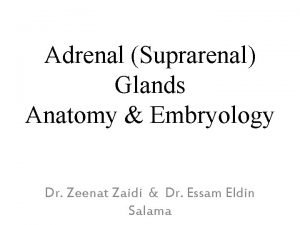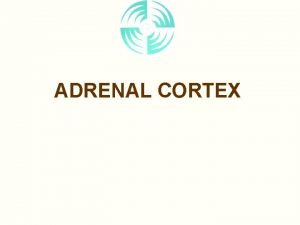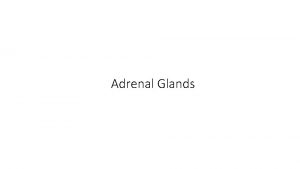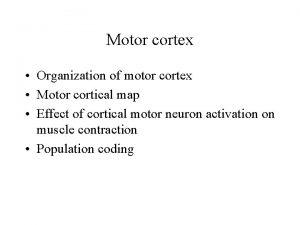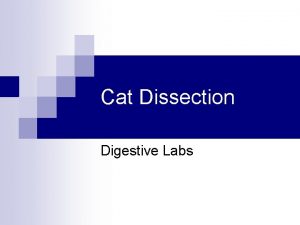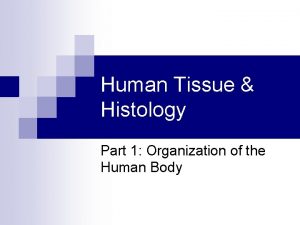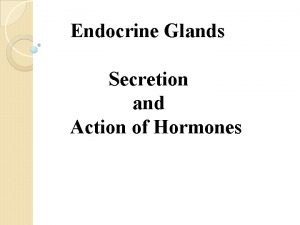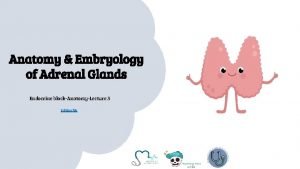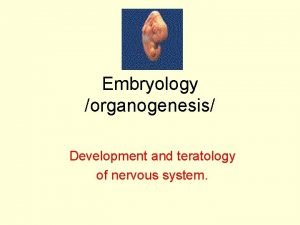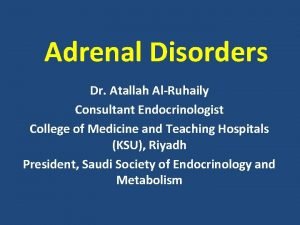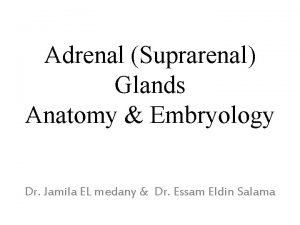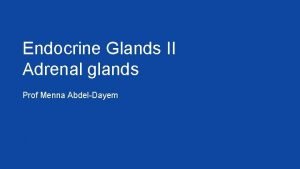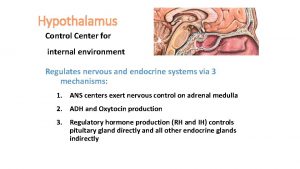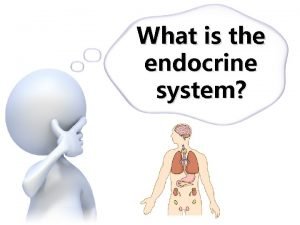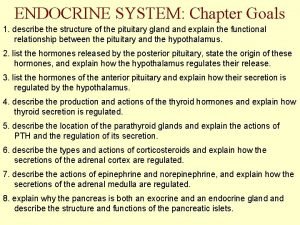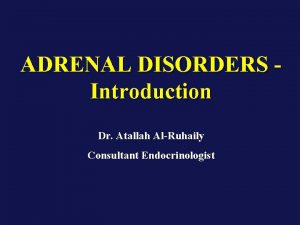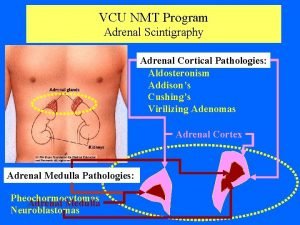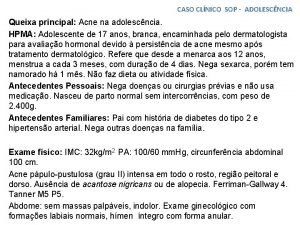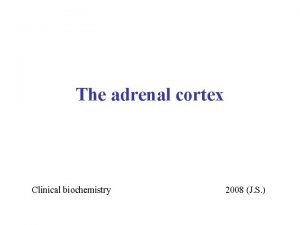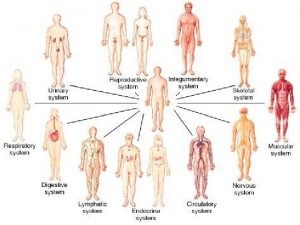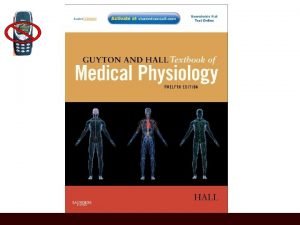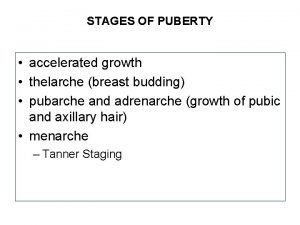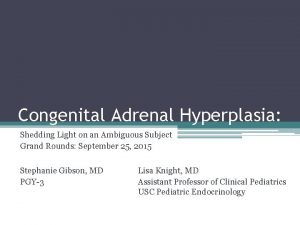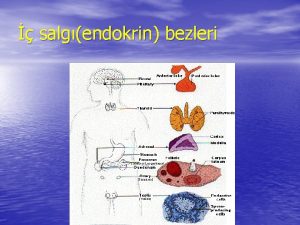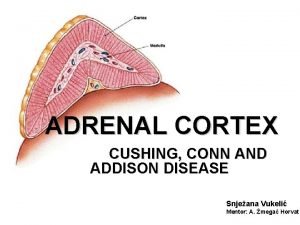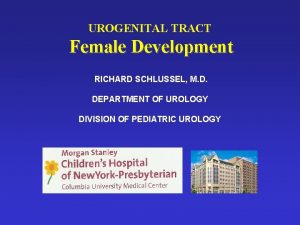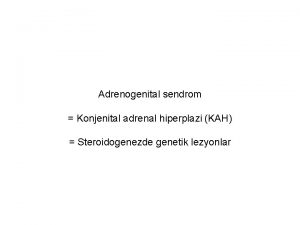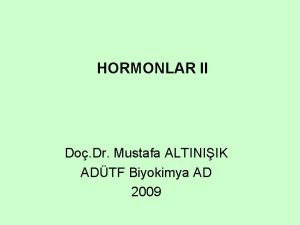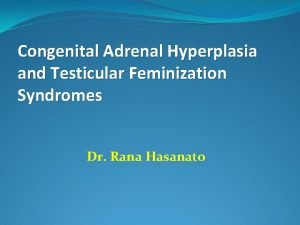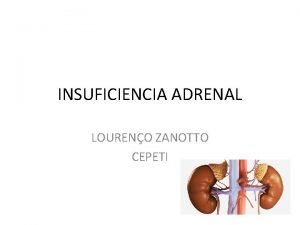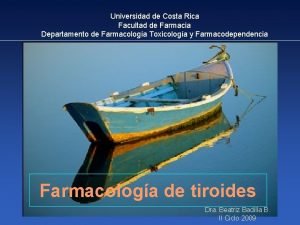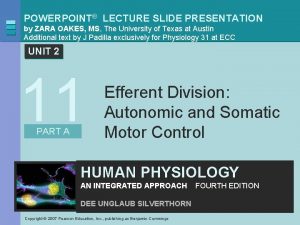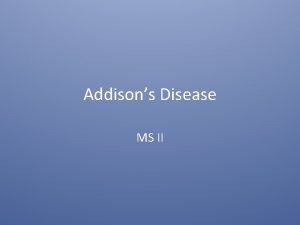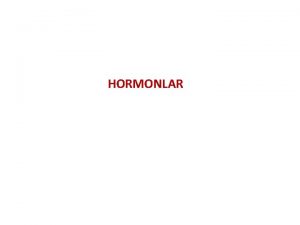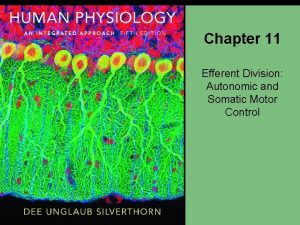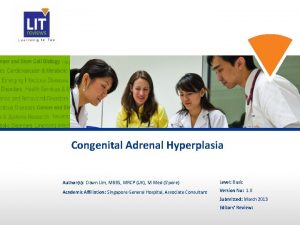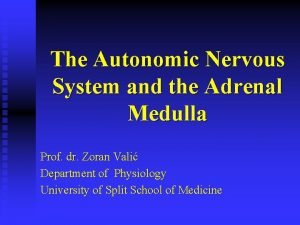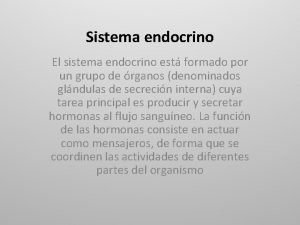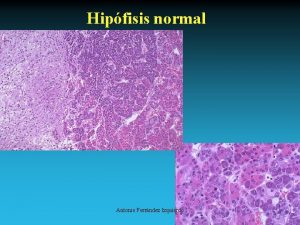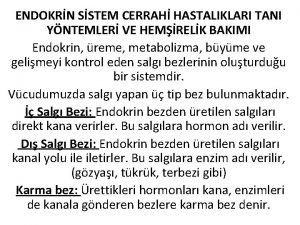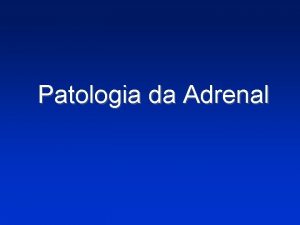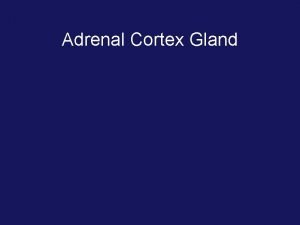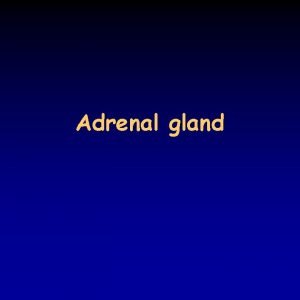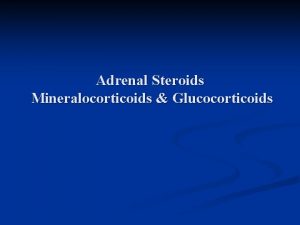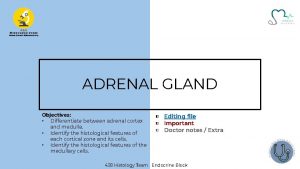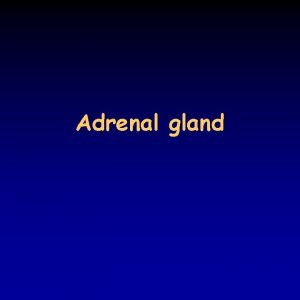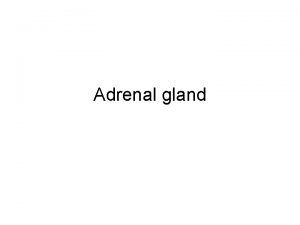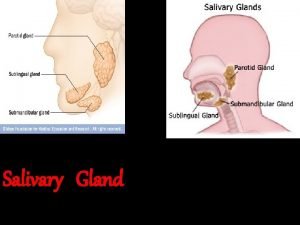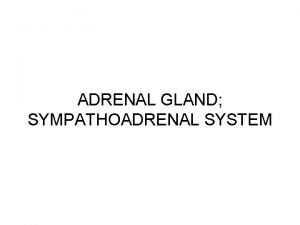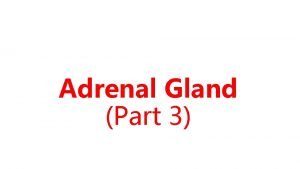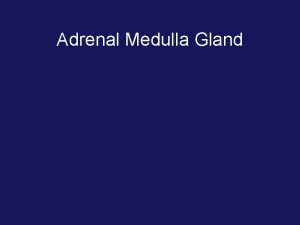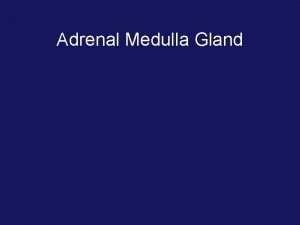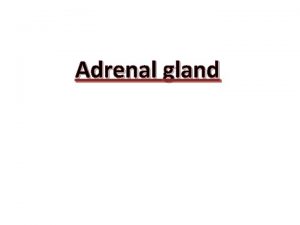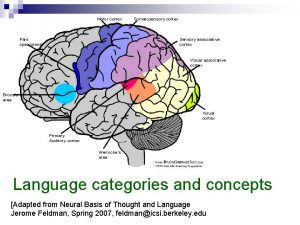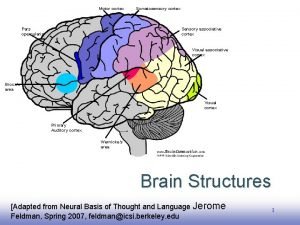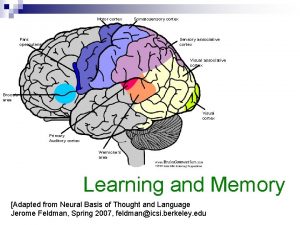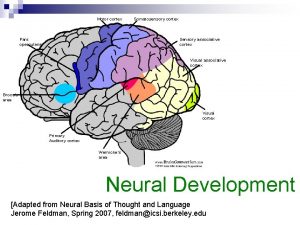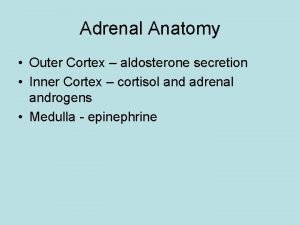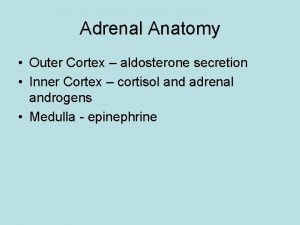Adrenal gland o The adrenal cortex produces three
































































- Slides: 64


Adrenal gland


o The adrenal cortex produces three major classes of steroids: (1) glucocorticoids (2)mineralocorticoids (3) adrenal androgens

Adrenal cortex o Zona glomerulosa (Aldrosterone) o Zona Fasciculata (Cortisol) o Zona reticularis( Androgen)




o Cholesterol, derived from the diet and from endogenous synthesis, is the substrate for steroidogenesis. o Uptake of cholesterol by the adrenal cortex is mediated by the low-density lipoprotein (LDL) receptor. o The principal glucocorticoid is cortisol (hydrocortisone).


Glucocorticoid Physiology

Glucocorticoid o regulation of protein, carbohydrate, lipid and nucleic acid metabolism. o Glucocorticoids raise the blood glucose by antagonizing the secretion and actions of insulin, inhibiting peripheral glucose uptake, it promotes gluconeogenesis. o protein breakdown and nitrogen excretion, inhibition of protein synthesis.

Glucocorticoid o Glucocorticoids have anti-inflammatory properties. o Cortisol impairs cell mediated immunity. o Cortisol has major effects on body water. It helps regulate the Extra Cellular Fluid Volume by retarding the migration of water into cells and by promoting renal water excretion, the latter effect mediated by suppression of vasopressin secretion, by an increase in the rate of glomerular filtration, and by a direct action on the renal tubule.


Mineralocorticoid Physiology

Renin-Angiotensin- Aldosterone system o Renin is a proteolytic enzyme that is produced in the granules of the juxtaglomerular cells surrounding the afferent arterioles of glomeruli in the kidney. o Renin acts on the angiotensinogen (in the liver) to form the angiotensin I. o Angiotensin I is then enzymatically transformed by angiotensin-converting enzyme (ACE), which is present in many tissues (particularly the pulmonary vascular endothelium), to the angiotensin II.

o Angiotensin II is a potent pressor agent and exerts its action by a direct effect on arteriolar smooth muscle. o angiotensin II stimulates production of aldosterone by the zona glomerulosa of the adrenal cortex.

o mineralocorticoids are considered major regulators of ECFV and are the major determinants of potassium metabolism. These effects are mediated by the binding of aldosterone to the MR in epithelial cells, primarily the principal cells in the renal cortical collecting duct.

Regulation of Aldosterone Secretion o renin-angiotensin system, o potassium o ACTH

o Potassium ion directly stimulates aldosterone secretion, independent of the circulating renin-angiotensin system, which it suppresses. o Potassium modifies aldosterone secretion indirectly by activating the local renin-angiotensin system in the zona glomerulosa.



Androgen physiology

o Androgens regulate male secondary sexual characteristics and can cause virilizing symptoms in women. o Adrenal androgens have a minimal effect in males whose sexual characteristics are predominately determined by gonadal steroids (testosterone). o In females several androgen-like effect( sexual hair) are mediated by adrenal androgens.

Hyperfunction of the Adrenal Cortex o Excess cortisol is associated with Cushing's syndrome o Excess aldosterone causes aldosteronism o Excess adrenal androgens cause adrenal virilism.

Causes of Cushing's Syndrome

o Pituitary-hypothalamic dysfunction o Pituitary ACTH-producing micro- or macroadenomas o ACTH or CRH-producing non endocrine tumors (bronchogenic carcinoma, carcinoid of the thymus)

o Adrenal macronodular hyperplasia o Adrenal micronodular dysplasia o Adrenal neoplasia( adenoma or carcinoma) o Exogenous (Prolonged use of glucocorticoids or ACTH) o

Sign or Symptom o Typical habitus (centripetal obesity ; Increased o o o body weight) Fatigability and weakness Hypertension Hirsutism Hypertrophy of clitoris Amenorrhea Broad violaceous cutaneous striae

o Personality changes o Ecchymoses o Proximal myopathy o Edema o Polyuria, polydipsia o Hyperglycemia





Diagnosis o The diagnosis of Cushing's syndrome depends on the demonstration of increased cortisol production and failure to suppress cortisol secretion normally when dexamethasone is administered.

Diagnosis o Cortisol after dexamethazone suppression test o ACTH o Urine 24 hours for cortisol o CT-scan and MRI of pituitary or adrenal

Treatment of Cushing's Syndrome p Trans sphenoidal resection of pituitary microadenoma p Radiation therapy p Bilateral adrenalectomy p Medical adrenalectomy (metyrapone, mitotane, aminoglutethimide, ketoconazole)


Adrenal insufficiency o Idiopathic o Infection o Surgery o Congenital o Hypothalamic and pituitary disease o exogenus



Sign and Symptom o Weakness o Pigmentation of skin o Wieght loss o Anorexia, nausea and vomiting o Hypotension and syncope




Diagnosis o Check sodium and potassium o blood sugar o cortisol after ACTH stimulation test

ACTH stimulation test(250 ug)

Treatment -Steroid and mineralocorticoid


Hyper Aldosteronism o Aldosteronism is a syndrome associated with hyper secretion of the mineralocorticoid aldosterone. o In primary aldosteronism the cause for the excessive aldosterone production resides within the adrenal gland. o In secondary aldosteronism the stimulus is extra adrenal.

Primary Aldosteronism with an Adrenal Tumor o Most cases involve a unilateral adenoma, which is usually small may. Rarely, primary aldosteronism is due to an adrenal carcinoma. Aldosteronism is twice as common in women as in men, usually occurs between the ages of 30 and 50, and is present in ~1% of unselected hypertensive patients.

Primary Aldosteronism Without an Adrenal Tumor o In many patients with clinical and biochemical features of primary aldosteronism, a solitary adenoma is not found at surgery. o These patients have bilateral cortical nodular hyperplasia. It is also termed idiopathic hyper aldosteronism , and/or nodular hyperplasia. The cause is unknown.

Signs and Symptoms o Hypertension o Potassium depletion o muscle weakness and fatigue o polyuria

Treatment of Aldosteronism o Primary aldosteronism due to an adenoma is usually treated by surgical excision of the adenoma.

o In idiopathic bilateral hyperplasia, surgery is indicated only when significant, symptomatic hypokalemia cannot be controlled with medical therapy(spironolactone, eplerenone, triamterene, amiloride). o Hypertension associated with idiopathic hyperplasia is usually not benefited by bilateral adrenalectomy.

Secondary Aldosteronism o Secondary aldosteronism refers to an appropriately increased production of aldosterone in response to activation of the renin-angiotensin system. o The production rate of aldosterone is often higher in patients with secondary aldosteronism than in those with primary aldosteronism. Secondary aldosteronism usually occurs in association with the accelerated phase of hypertension or on the basis of an underlying edema disorder.

Causes of Secondary Aldosteronism o Renin producing tumor o decrease of renal blood flow o edematus state o pregnancy

o Secondary aldosteronism in pregnancy is a normal physiologic response to estrogen-induced increases in circulating levels of renin substrate and plasma renin activity and to the anti aldosterone actions of progestogens.


o. Cogenital adrenal hyperplasia


CAH o Autosomal recessive trait o Most common form is due to 21 - hydroxylase deficiency. o Severe forms occurs in infancy.

Clinical manifestation o Mild form hirsutism , oligomenorrea o severe form hypotension, hypoglycemia, hyperkalemia hyponatremia , ambigous genitalia

o High 17 -OH-progesterone blood level o Treatment : cortisol and mineralocorticoid replacement and Corrective surgery
 Adrenal cortex develops from
Adrenal cortex develops from Adrenal medulla cortex
Adrenal medulla cortex Zona fasciculata
Zona fasciculata Zona reticularis gonadocorticoids
Zona reticularis gonadocorticoids Motor cortex sensory cortex
Motor cortex sensory cortex Cat dissection
Cat dissection Adrenal gland epithelium
Adrenal gland epithelium Ectocrine
Ectocrine Betoderm
Betoderm Parasympathetic and sympathetic
Parasympathetic and sympathetic Neural plate formation
Neural plate formation Acth
Acth Adrenal gland regions
Adrenal gland regions Adrenal gland relations
Adrenal gland relations Adrenal gland regions
Adrenal gland regions Corticoliberin
Corticoliberin Adrenal gland
Adrenal gland Summary of adrenal gland
Summary of adrenal gland Pituitary gland and pineal gland spiritual
Pituitary gland and pineal gland spiritual Pineal gland pituitary gland
Pineal gland pituitary gland Adrenal glands
Adrenal glands Adrenal cushing
Adrenal cushing Estadiamento de tanner
Estadiamento de tanner Adrenal hormone pathway
Adrenal hormone pathway Third gender full body parts pictures
Third gender full body parts pictures Congenital adrenal hyperplasia
Congenital adrenal hyperplasia Congenital adrenal hyperplasia characteristics
Congenital adrenal hyperplasia characteristics 17 hydroxyprogesterone levels
17 hydroxyprogesterone levels Adrenal bez histolojisi
Adrenal bez histolojisi Nursing diagnosis of adrenal tumor
Nursing diagnosis of adrenal tumor Conn vs addison
Conn vs addison Schlussel urology
Schlussel urology Pseudohermafrodit
Pseudohermafrodit Adrenal korteks hormonları
Adrenal korteks hormonları Histology thyroid gland
Histology thyroid gland Dr wilson adrenal rebuilder side effects
Dr wilson adrenal rebuilder side effects Congenital adrenal hyperplasia characteristics
Congenital adrenal hyperplasia characteristics Arritimias
Arritimias Adrenal drugs pharmacology
Adrenal drugs pharmacology Levotironina
Levotironina Objectives of stress
Objectives of stress Adrenal sympathetic pathway
Adrenal sympathetic pathway Adrenal insufficency
Adrenal insufficency Hormonların çalışma mekanizması
Hormonların çalışma mekanizması Adrenal sympathetic pathway
Adrenal sympathetic pathway Endocrine system function
Endocrine system function Psödo cushing sendromu
Psödo cushing sendromu Dr dawn lim
Dr dawn lim The adrenal medullae secrete
The adrenal medullae secrete Hipotiroidismo congénito primario
Hipotiroidismo congénito primario Adrenal tumour
Adrenal tumour Adrenal kriz acilci
Adrenal kriz acilci Adrenal bezin hipofonksiyonu sonucu gelişen tablo
Adrenal bezin hipofonksiyonu sonucu gelişen tablo điện thế nghỉ
điện thế nghỉ Một số thể thơ truyền thống
Một số thể thơ truyền thống Trời xanh đây là của chúng ta thể thơ
Trời xanh đây là của chúng ta thể thơ Số nguyên là gì
Số nguyên là gì Phối cảnh
Phối cảnh Các châu lục và đại dương trên thế giới
Các châu lục và đại dương trên thế giới Thang điểm glasgow
Thang điểm glasgow Thế nào là hệ số cao nhất
Thế nào là hệ số cao nhất Sơ đồ cơ thể người
Sơ đồ cơ thể người ưu thế lai là gì
ưu thế lai là gì Tư thế ngồi viết
Tư thế ngồi viết
